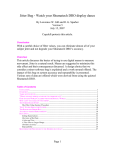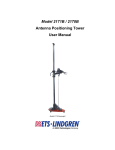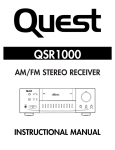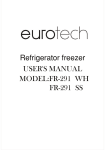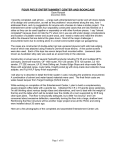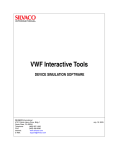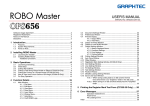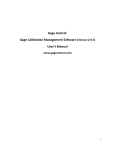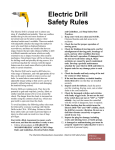Download Jigsaw Safety - charlottewoodworkers.org
Transcript
Jigsaw Safety Rules The Jigsaw is a versatile, practical tool useful for many purposes. It can be used for cutting straight lines or curves, and most models allow the base to be tilted for cutting bevels. While a Jigsaw won’t provide the fine cuts and intricate detail that can be achieved with a scroll saw, it’s handheld and very portable. There are cordless models that can even be taken to places where electrical outlets simply aren’t available. Cordless models aren’t perfect, of course, they can run low on battery power, and so they don’t have the apparently unlimited cutting stamina of their cord tethered counterparts. Whether you want to build a small box to store garden tools or cut out the parts for a wooden toy, cut a pair of brackets to hold a fireplace mantle, or a few pieces of colored plastic to make a wind catcher to hang on the back porch, with the correct blade selection, a Jigsaw is up to the task. It is somewhat similar to a band saw in the way it can navigate curves, but it can’t cut stock as thick as the bandsaw can. Still the Jigsaw isn’t limited by the size of its table or the depth of its throat as the band saw is. The Jigsaw can easily cut large pieces of wood if they’re not thicker than its blade can handle. If you want to build your own version of Santa’s sled from plywood and framing lumber and make it large enough is sit in and wave to the passing cars on the night before Christmas, the Jigsaw can do that without “breaking a sweat”. Jigsaws operate using a quick reciprocating up and down motion and cut while the blade is coming up. Replacement blades are usually easy to find if your saw uses a standard shank configuration, and they typically aren’t difficult to change. To avoid accidents, the following safety rules must be followed by everyone working with Jigsaws in the CWA / JPM shop. Failure to follow these safety rules can result in personal injury or injury to others and can result in a loss of shop privileges. Start with a Risk Assessment to ensure a safe work area, and that the machine is ready to use: 1. Follow all procedures in CHARLOTTE WOODWORKERS’ ASSOCIATION Shop Rules and Guidelines, Electrical Safety Rules and Guidelines, and Shop Safety Best Practices. 2. Keep your work area clean and well lit. Cluttered benches and dark areas invite accidents. 3. Check the tool for proper operation of moving parts. 4. Check for binding of moving parts, and for misalignment of moving parts, breakage of parts, and any other condition that may affect the tool’s operation. If damaged, have the tool serviced before using it. Many accidents are caused by poorly maintained tools. Develop a periodic maintenance schedule for your Jigsaw and follow it. 5. Inspect tools for any damage prior to each use. 6. Check the handle and body casing of the tool for cracks or other damage. 7. If the tool has auxiliary or double handles, check them all to see that they are installed securely. 8. Inspect cords for defects: check the power cord for cracking, fraying, and other signs of wear, cuts or other faults in the cord insulation. 9. Check for damaged switches and switches with faulty trigger locks. Do not use the tool if the switch does not turn it “ON” or “OFF” reliably. Any tool that cannot be controlled with the switch is dangerous; have it repaired. The Charlotte Woodworkers Association | Jigsaw Safety Rules Effective 3/3/14 DP/WJ 10. While checking that the switch turns the Jigsaw “On” and “Off” reliably, check the saw for excessive vibration. Do not use a saw that vibrates excessively or appears unsafe in any way. 11. Inspect the plug for damage; including cracks and missing, loose or faulty prongs. 12. A damaged or malfunctioning part must be properly repaired or replaced prior to use to avoid risk of personal injury. 13. Don’t operate corded Jigsaws in damp or wet locations. If operating the Jigsaw in a damp location is unavoidable, use a ground fault circuit interrupter (GFCI) protected supply to power the tool. Use of a GFCI protected supply reduces the risk of serious electric shock. Electrician’s rubber gloves and footwear will further enhance your personal safety. Remember; NEVER wear gloves while using revolving power tools. The Jigsaw is a reciprocating tool. The risk is different with this type of motion. While you normally wouldn’t wear gloves while using the Jigsaw, when working in a damp location the rubber electrician’s gloves offer additional protection from electrical shock. Be Alert: Keep your hands (and gloves) away from the moving blade. Even with rubber gloves, nonconductive footwear and GFCI protection, AVOID RUNNING A CORDED JIGSAW WHILE STANDING IN WATER!!! 14. Keep the area around where you’ll be working clear of people and debris that could impair your traction or footing to avoid potential slips and falls. 15. The Jigsaw blade will cut anything it comes into contact with if that object can be cut. This includes bystanders or your own body if you aren’t aware of where you’re guiding it. BE CAREFUL!!! 16. Dress properly. Do not wear loose clothing or jewelry. If you’re wearing jewelry such as necklaces, bracelets, or rings that could become caught or entangled in moving parts, remove it and store it safely. Roll up long sleeves. 17. In general, the best practice is not to wear gloves. The only exception is when wearing electrician’s rubber gloves if working in a damp location. There are times when the areas 18. 19. 20. 21. 22. 23. 24. 25. 26. 27. around the loading docks at the shop might be damp, and if you’re using the Jigsaw in those locations the electrician’s gloves could provide additional protection from electrical shock. If you’re working in our shop environment it should never be too cold to work without gloves. If it is, ask a Shop Foreman to have someone turn on a heater. Tie back, or otherwise secure, long hair. Keep your hair, clothing, and gloves, if gloves must be worn for safety reasons, away from moving parts. Loose clothes, jewelry, or long hair can be caught in moving parts. Keep handles dry, clean and free from oil and grease. Never carry the saw with your finger on the power switch (trigger). Carrying tools with your finger on the switch or plugging in tools that have the switch “ON” invites accidents. Remove adjusting keys and/or wrenches before turning the tool “ON”. A wrench or an adjusting key that is left attached to a moving part of the tool may cause personal injury to the operator or a bystander. There’s also the possibility that it may damage the tool, the adjusting key or wrench or the material being worked on. Use safety equipment. Always wear eye protection. Non-skid safety shoes, hard hat, and hearing protection must be used when situations call for them. Safety glasses with side shields or a face shield must be worn. Everyday eyeglasses are only made of impact resistant glass, they aren’t safety glasses. If you’re not wearing actual safety glasses, wearing safety goggles over your regular glasses can provide the protection you need. Hearing protection should always be worn. Use the appropriate dust mask or respirator in dusty work conditions. Jigsaws create dust, and by nature of the way they cut they’ll be pulling that dust toward you. Give the work your undivided attention. Operational Safety Rules: 1. Approach your work in the Shop & while using the Jigsaw with a safe attitude! 2. Read the manual of operating/safety instructions (User’s Manual) that came with The Charlotte Woodworkers Association | Jigsaw Safety Rules Effective 3/3/14 DP/WJ 3. 4. 5. 6. 7. 8. 9. 10. the Jigsaw. If you can’t find it and if the Shop Foreman can’t help you find it, someone can download a copy of the manual from the internet. This manual should tell you where the various switches and controls for the Jigsaw are and how they’re supposed to work. If you don’t know how to use the Jigsaw properly for the cuts you’d like to make, get instruction on how to use it correctly for what you want to do BEFORE beginning. Keep bystanders, children, and visitors away from the work area while operating a power tool. Having anybody not involved in the sawing operation in the immediate area can create distractions that can cause you to lose control. Stay alert, watch what you are doing and use common sense when operating a power tool. Do not use tools while tired or under the influence of drugs, alcohol, or medication. A moment of inattention while operating power tools may result in serious personal injury. Keep the Jigsaw’s air vents clear to maintain adequate ventilation. Proper ventilation helps keep the saw from overheating while in use. Keep power cords away from the blade, heat, water and oil. When cutting make sure you place the cord in such a way that you won’t cut through it by accident. Be aware of the location and setting of the switch "Lock-ON" button if your saw has one. If the switch is locked "ON" during use, be ready for emergency situations by being ready to switch it "OFF", by first pulling the trigger then immediately releasing it without pressing the "Lock-ON" button (on most Jigsaws). Make sure you try this procedure often enough to become comfortable with it BEFORE plugging the saw in. Always make sure that the switch is “OFF” before plugging the Jigsaw in or installing its battery pack. Some saws have lock-on trigger switches to help operators avoid fatigue. Never leave the trigger locked "ON". Before plugging the tool in, check that the trigger lock is "OFF". Accidental start-ups can cause injury. Never unplug tools by pulling on the power cord. When unplugging equipment pull on the plug, not on the cord. 11. Most new Jigsaws have insulating handles. Hold the Jigsaw by the insulated gripping surfaces when performing an operation where the cutting tool may contact hidden wiring or its own cord. On most handheld power tools, Jigsaws included, contact with a "live" wire will make exposed metal parts of the tool "live" which can shock the operator. Do not drill or cut into existing walls or other blind areas where electrical wiring may exist. If this situation is unavoidable, disconnect all fuses or circuit breakers feeding that part of the worksite before proceeding. 12. Be aware of how far the Jigsaw blade moves as the saw is running. Keep your hands and all other parts of your body, as well as those of any helper or assistant, at least 3 inches from any portion of this range of movement. Don’t forget the fact that the blade moves forward and backward on Jigsaws with orbital action and be sure to stay clear of that entire range of blade motion. 13. Do not reach under the material being cut. The proximity of the blade to a hand that’s under the material being cut is hidden from your sight. Caution all assistants to avoid putting any body part in the areas where the Jigsaw blade may be traveling and warn them not to reach under the material being cut. 14. Do not overreach. Keep proper footing and balance at all times. Proper footing and balance enables better control of the tool in unexpected situations. 15. Don’t put your hands between the gear housing and the saw blade holder. The reciprocating blade holder can pinch your fingers. (And NOT gently either!) 16. Make sure the blade is the proper type for the material and cut you are planning. 17. Do not use dull, bent or damaged blades. Bent blades can break easily or cause kickback. 18. Insert the blade with the teeth pointing forward and up toward the body of the Jigsaw. 19. Jigsaws on the market today use several different approaches to the way blades are installed and locked into the saw. Some replacement blades are available that will work properly with more than one shank configuration. Starrett’s Unified Shank blades The Charlotte Woodworkers Association | Jigsaw Safety Rules Effective 3/3/14 DP/WJ are an example of this. It’s important that the blade you intend to install be compatible with the blade shank type used by the Jigsaw you’re installing it into. If you have access to the user’s manual for the Jigsaw you’re working with, the instructions there should show the required shank type used on that saw and explain how to install that type of blade properly. Otherwise, if you need assistance, ask the Shop Foreman to help you find someone who can guide you as you perform this operation correctly. 20. Even Jigsaws that use blades with the same shank configuration vary in the way blades are installed and locked into place. Here again, consulting the user’s manual for the model of Jigsaw you’re working with is the proper first step in learning how to do this for the first time. If you still have questions, you should ask the Shop Foreman to direct you to someone with the experience to help you perform the operation you’re trying to complete. 21. Most Jigsaws have tilting footplates or “shoes”. Adjusting the angle of the Jigsaw’s footplate lets the saw make bevel cuts. Like so many other features on Jigsaws, the way the footplate angle is adjusted varies between different Jigsaw models. The user’s manual is the best reference source if you don’t know how to make this adjustment on the Jigsaw model you’re using. If you don’t find the help you need there, ask the Shop Foreman to direct you to someone who can give you the assistance you need. If you do need to adjust the angle of your saw’s footplate, ensure that you lock the setting securely before using the saw. If you change the footplate setting away from the standard of 90 degrees, reset it exactly to 90 degrees and lock the setting securely before storing the saw when you’ve finished using it. 22. Most Jigsaws are variable speed tools; use the proper speed for the job and type of stock you are cutting. This is a situation where referring to the user’s manual that came with the Jigsaw you’re using would be wise. In general, when adjusting the speed of the Jigsaw choose slower speeds for finer cuts and when cutting dense materials and plastics. Choose faster speeds for quicker, rougher cuts in lighter woods and materials. Be aware that other factors influence the rate of cutting in addition to the speed selection. Blade type and sharpness and the orbit setting on Jigsaws that support that feature may have a greater impact on overall cutting speed, but the speed selected always has some role to play and should be adjusted to optimize the cutting performance of the saw you’re using. Adjusting the saw’s variable speed properly helps ensure that the Jigsaw performs in the most predictable manner possible and plays a key role in producing the best quality cut possible with the installed blade. 23. Jigsaw trigger controls (switches) also differ between models. To be able to operate the Jigsaw safely, you must understand how the trigger on your specific Jigsaw works and why it works the way it does. The largest percentage of new model Jigsaws have triggers that simply turn the tool on and off, depending on whether the trigger is pulled or not. There are some models, however, that have variable triggers (generally in addition to variable maximum speed settings). This style of trigger starts the blade moving slowly as you begin to squeeze the trigger and gets faster and faster until the saw reaches the speed that you’ve set with the variable speed control when the trigger is completely depressed. Safe use of a saw with such a variable trigger is best covered by the manufacturer’s user’s manual, and I encourage you to go to that document for further insight and instruction. If that approach is unsuccessful and you still have questions, ask the Shop Foreman to direct you to someone who can help you understand how that particular feature is intended to be used on the model of Jigsaw that you’re using. 24. Most new Jigsaws have selectable blade orbits. This feature moves the blade forward slightly while the blade travels up, which causes it to cut more aggressively than if the blade just moved straight up and down. The orbiting action also moves the saw blade back slightly on the down stroke which clears the kerf and saves wear on the blade. Adjusting the amount of blade orbit makes the saw cut more or less aggressively. According to Rockler, (http://www.rockler.com/how-to/testing-topshelf-jigsaws/) typical modern Jigsaws have four orbit settings: 0 (no orbit) or 1 for cutting metals and plastics; 1 or 2 for fine and curved The Charlotte Woodworkers Association | Jigsaw Safety Rules Effective 3/3/14 DP/WJ cuts; and 3 (maximum orbit) for faster, rougher cuts. It’s important to set the blade orbit correctly for the type of material you’ll be cutting and for the quality of finish you expect to achieve on the finished cut. From a safety point of view, you also need to be aware that when the Jigsaw is set for an aggressive cut, it will move much more rapidly through the material being sawn and you need to be prepared for the increased rate of travel. As with all such adjustments, the user’s manual for the specific model of Jigsaw that you’re working with is the best reference when choosing the blade orbit setting. 25. Most modern Jigsaws have a sawdust blower that blows a stream of air to help keep the cutline free of sawdust. While this is generally a helpful feature and should be used, be aware that having sawdust blown away from the cutline raises dust that you can breathe or that can get in your eyes. Wear proper safety glasses and a well-fitted dust mask or respirator. On a few Jigsaw models, this blower can be turned off for those situations where you don’t want dust blown around, such as when cutting exotic wood whose sawdust is a known irritant or carcinogen. 26. Dust collection solutions, and from what I’ve read, I use the word solutions lightly, are available on some modern Jigsaws either with the saws when they’re shipped from the factory, or as optional features that can be purchased separately. In addition to all other parts of the dust collection path on these saws, most of these “dust collection solutions” incorporate a shield of sorts that covers the area in front of the blade to help focus the vacuum from the dust collector. While these shields start out clear, the plastic that they’re typically made of attracts dust, which sticks to the shield and blocks the user’s view of the cutline. Only a few are made of a plastic material that doesn’t do this. Naturally it’s worth checking the performance of the dust collection for your Jigsaw model if it shipped with the saw. However, if that feature’s an option that must be purchased separately, or fails to collect dust reliably without obscuring the operator’s view of the cutline, and if you need a dust collection solution with the material you’re cutting, investigate an alternative 27. 28. 29. 30. 31. arrangement. Often you can put together something using a vacuum hose that will pull the chips and fine dust from the area where the saw is cutting and arrange it so that it will do this without blocking the line of vision to the cutline. Remember that the key requirements for successful dust collection are that the dust is removed while still allowing you to see the line that you’re sawing to. Use only accessories that are recommended by the manufacturer for your model of saw or that are approved for use with your specific Jigsaw model. Accessories that may be suitable for one model of a tool may become hazardous when used on another model. Secure material before cutting. Secure and support it as close as possible to the cutline to reduce vibration. Clamp it a bench, support it with sawhorses, or use similar work aids for support. NEVER support stock to be cut with any part of your body (or an assistant’s body). Don’t hold it in your free hand; clamp it properly to an appropriate surface. Holding the work by hand or against your body is dangerous and unstable; taking that approach may lead to loss of control and could lead to serious injury. Make sure all supports, clamps and holding devices are clear of the cutline before continuing. Support large workpieces well to reduce issues with blades binding and potentially breaking. If a blade binds while cutting, release the trigger immediately to stop the saw. If you are using a trigger lock, disengage the trigger lock immediately to achieve this result. If a blade binds, the Jigsaw can be lifted clear of the workpiece and slammed back down at the stroke rate the saw is running at. While taking steps to stop the saw, keep you free hand clear of the area where the footplate will be hitting the workpiece. Once the saw comes to a stop, free the blade and check it, and the saw, for damage. Fix any damage you find, correct the conditions that caused the blade to bind, and resume cutting. Be sure that the workpiece is firmly secured while the Jigsaw is running and after release the trigger until the blade comes to a complete stop. The Charlotte Woodworkers Association | Jigsaw Safety Rules Effective 3/3/14 DP/WJ 32. Small or thin material may flex or vibrate with the blade while you’re cutting, causing loss of control. 33. Make certain that all locking adjustments are properly locked and the blade is secured properly before plugging the saw in. Loose adjustments or Jigsaw blades can cause the tool or blade to slip and loss of control may result. A general best practice is to lock each adjustment properly before moving on to the next task as you make the Jigsaw ready for the cuts you’re planning to make. NOTE: properly tightened means just that, follow the instructions in the user’s manual or other reliable reference. These parts can be over tightened too, so be sure you know how tight is “properly” tightened. 34. Do not start the Jigsaw with the blade in contact with the workpiece. 35. Before starting the cut, hold the footplate against the stock near where you want to start the cut, turn the tool "ON" and allow the blade to come to full speed. The tool can chatter or vibrate if the blade speed is too slow at the beginning of the cut and could possibly kick back. If you have a saw with trigger speed control, refer to the user’s manual for directions on its safe use. 36. The Jigsaw cuts stock on the upstroke but is sharp enough to cut you while clearing the kerf on the down stroke. Because the blade cuts while traveling upward, it helps keep the footplate firmly against the workpiece. 37. Never insert a blade into a cut or pilot hole unless the saw is stopped. Don’t withdraw the blade from a cut or pilot hole until you allow the blade to come to a complete stop. Attempting these types of actions while the saw blade is still moving can result in the blade repeatedly striking the upper surface or the workpiece which can bend or even break the blade. 38. Maintain firm contact between the footplate and the stock while making the cut. This doesn’t require a great amount of force; you just need to hold the saw against the stock while you’re cutting. 39. Keep a firm grip on the Jigsaw to maintain control and get the cleanest possible cut. Here again, firm means firm, not a knuckle whitening clenched grip. 40. Do not force the Jigsaw. This is especially important when making curved cuts. Let the saw cut at its own natural pace and let it turn gently through curved cuts for best results. If the Jigsaw is the correct tool for your application and is set up properly with the right blade for the work you’re trying to do it should work smoothly. The correct tool, properly configured, will do the job better and more safely at the rate it was designed for. If you’re having problems, contact the Shop Foreman who can help you determine what’s going wrong. 41. Forcing a cut will result in poor cut quality and can result in damage to the blade and/or the saw. 42. Before making any adjustments, performing maintenance, changing accessories, or changing the blade, turn the Jigsaw “OFF”, let it come to a complete stop, then unplug it or remove the battery pack. Such preventive safety measures reduce the risk of starting the tool accidentally. 43. When removing blades or accessories after the saw has been running, do so with CARE! The blades are SHARP, and after you’ve been using the saw for a while they can be HOT! When removing the blade from the Jigsaw use proper protective gloves when grasping the blade to avoid cutting, and possibly burning, yourself. Gloves will also provide protection when working with Jigsaw accessories that may be hot after prolonged use. 44. If your tool is equipped with a dust bag, empty it frequently during use and after completion of sawing for the day. Depending on the environment you’re working in, spontaneous combustion of dust left in these bags may, in time, result from a mixture of oil or water with dust particles. Be extremely careful of dust disposal, materials in fine particle form may be explosive. Do not throw the dust bag contents on an open fire. 45. Some dust created by power sanding, sawing, and grinding, drilling, and other construction activities contains chemicals known to cause cancer, birth defects or other reproductive harm. Some examples of these chemicals are: • Lead from lead-based paints The Charlotte Woodworkers Association | Jigsaw Safety Rules Effective 3/3/14 DP/WJ 46. 47. 48. 49. 50. • Crystalline silica from bricks, cement and other masonry materials • Arsenic and chromium from chemically treated lumber Your risk from these exposures varies, depending on how often you do this type of work. To reduce your exposure to these chemicals: work in a well ventilated area, and work with approved safety equipment, such as those dust masks that are specially designed to filter out microscopic particles. Never abuse the power cord. Never use the cord to carry the Jigsaw. Maintain tools with care. Keep cutting tools sharp and clean. Properly maintained tools, with sharp cutting edges, are less likely to bind and are easier to control. Any alteration or modification of the Jigsaw is considered misuse and may result in a dangerous condition. Inspect your stock carefully before cutting it. Stock should be clean, free of dirt and other debris, and not have metal fasteners of any kind in the area that will be cut. Never place your hands or fingers directly in line with the blade’s path. If you do you could cut them if you slipped, or if the Jigsaw moved forward more rapidly than you anticipated. Make relief cuts before cutting long or sharp curves. This will help prevent the blade from binding and possibly breaking. The dashed lines show potential relief cuts. 51. STOP the saw and wait until blade has come to a complete stop before moving small scrap & cut off pieces away from Jigsaw. 52. For safest cutting, the footplate needs to be able to travel over a relatively smooth surface on the workpiece. 53. Do not cut a workpiece that is too small to be safely supported and held securely. 54. When taking a break or when finished cutting for the day, unplug the saw or remove the battery pack, remove the blade and store the Jigsaw and all its parts properly, out of the reach of children and other untrained persons. Tools are dangerous in the hands of untrained users. 55. Before storing the Jigsaw for the day, clean it to remove sawdust so that it will be free of debris when the next person wants to use it. Coil the cord neatly (if it has one), and then store it properly. Maintenance and Service 1. Tool service must be performed only by qualified repair personnel. Service or maintenance performed by unqualified personnel could result in a risk of injury. For example: internal wires may be misplaced or pinched, safety guard return springs may be improperly mounted. If a tool belonging to CWA or our host organization needs maintenance, contact the Shop Foreman. If the tool is still under warranty, they will make arrangements for the service to be done under the warranty. If the manufacturer’s warranty has expired, they will ensure that the tool is repaired by properly qualified repair personnel. 2. When servicing a tool, use only identical replacement parts. Follow instructions in the Maintenance section of the manual applicable to that make and model of tool. Use of unauthorized parts or failure to follow the correct maintenance instructions may create a risk of electric shock or injury. Certain cleaning agents such as gasoline, carbon tetrachloride, ammonia, etc. may damage plastic parts. Before using chemical cleaning agents on a tool check the manual for that make and model of tool for approved cleansers and cleaning procedures. The Charlotte Woodworkers Association | Jigsaw Safety Rules Effective 3/3/14 DP/WJ







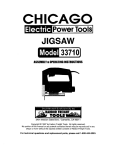

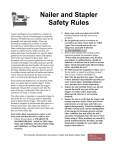
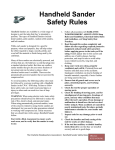
![[1]Oracle® DIVAdirector](http://vs1.manualzilla.com/store/data/005731358_1-211e3778ae12716a403cbbeaab90ad2a-150x150.png)
